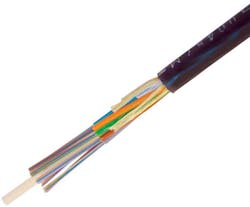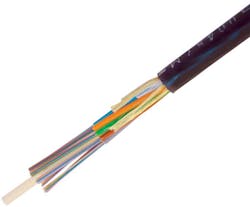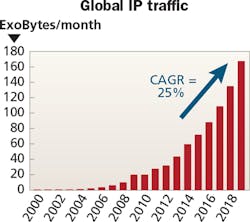Impact of increased bandwidth on the fiber network
By David Mazzarese
The amount of information traveling on the Internet continues to grow as more devices are connected and new applications are developed. This growth is illustrated in the Cisco Visual Networking Index, which shows Internet Protocol (IP) traffic across the globe increasing at a compounded annual growth rate (CAGR) of about 25 percent per year.
Common applications such as web browsing and high-definition video make up approximately two-thirds of this traffic. The greater availability of high-speed bandwidth results in even more. Because the entire system is interconnected, growth in any portion of the network will result in similar growth in other portions. Optical fiber is the only transmission medium capable of supporting this explosive growth.
In the virtual world of IP packets, binary-code 1s and 0s don’t jump from transceiver to transceiver; instead, they are transmitted over a physical network. This physical infrastructure consists of a series of fiber-optic segments, each designed to support different network applications. Understanding the evolution of transmission strategies deployed on the fiber segments can help us understand and predict how the fiber network may grow and evolve over time.
Information passes through the entire optical network, but the requirements for delivering such information are different depending on the network segment being discussed. Consider three major portions of the network: access, data centers and metro/long haul.
The access network
The access network connects an individual, company or device to the global network. Some applications (such as instant messaging) require low bandwidth (approximately 20 kb for a text message), while others (such as streaming high-definition video) require high bandwidth (approximately 4 Megabytes for a four-minute video).
Given greater bandwidth, people inevitably use it for a better user experience, perhaps with higher-quality video, faster downloads or lower latency. In fact, the availability of high-speed Internet can impact many lifestyle choices, including where to live or where to vacation.
The highest-bandwidth connections in the access network are found when fibers are connected directly to homes. But connecting high-speed broadband to the inside of the living units has traditionally been costly in fiber-to-the-home (FTTH) networks. Some service providers have considered deploying G.Fast, which uses existing copper infrastructure inside the premises as a way to avoid bringing an optical fiber directly into a home.
While this provides an easier way to deliver higher-speed broadband, the bandwidth achieved with G.Fast is not as high as the competing GPON (Gigabit Passive Optical Network) architecture. The development of ITU-T G.657 bend-insensitive singlemode fibers has enabled innovative cable and connectivity designs that have greatly reduced the cost to connect a household. The net result is more FTTH connections. However, with only about 10 percent of the world’s population connected by fiber, a large number of houses are still connected using lower-speed technology.
Mobile devices are another key element in the access network. Supplying mobile devices with very high speed (1 Gbit/sec) bandwidth is challenging. Frequency space is limited, and delivering ultrafast broadband over mobile devices requires a significant increase in the number of cell sites to accommodate user demand.
The data center
The demand for data storage is exploding. Every video that is streamed or downloaded is stored somewhere. Every social networking site has its data stored as well. As a result, most of the information traveling over access networks moves back and forth between a data center and the user. Approximately one-third of the traffic exiting data centers is used to communicate with other data centers, either for backup purposes or for efficiency in delivering information to end users. For each bit of information that enters a data center, approximately four bits are passed within the data center.
Economics favors larger and faster data centers. State-of-the-art centers are operating at 10 Gbits/sec or faster, which favors transport over optical fibers rather than copper cables. Large data centers have many thousands of connections, with an average transmission distance of less than 100 meters. This situation, along with the massive deployment of MPO connectors, has resulted in the widespread deployment of Om3 and Om4 multimode fiber cables in the data center.
New trends in optical fiber development have included wideband multimode fiber (WBMMF) designed for operation from 840 nm to 950 nm, to enable multiple wavelengths to be deployed on a single multimode fiber. In this way, data center operators can reduce the number of optical fibers deployed to create an optical link and also provide lower-cost solutions for creating the large number of optical links found in a data center. Based on current trends, data centers will continue to grow, and it is likely that next-generation data center transmission will be 4x25G shortwave wavelength division multiplexing (SWDM) to enable 100-Gbit/sec transmission over a pair of wideband multimode fibers.
Long-haul and metro networks
Long-haul and metro networks transport information between users and their data sources. Here, the service provider must offer enough bandwidth to ensure that transport across this portion of the network does not create a bottleneck, slowing the movement of information. Higher transmission rates and WDM combine to maximize the amount of traffic that travels over the deployed fiber.
With network traffic growing at 25 percent per year, traffic on each fiber is expected to double every three years. Combined with the expected usable life of fiber at more than 25 years, network traffic on a given fiber can be expected to grow more than 100 times during its expected life span.
One challenge with this anticipated growth is that the information-carrying capacity of a singlemode optical fiber may be maximized during the cable’s lifetime. This boundary is known as the spatial spectral efficiency-the limit on the amount of data an optical fiber can transmit. The industry speculates that this will occur at single-channel transmission speeds of about 1 Terabit per second (1 Tbit/sec), and the combined DWDM channels will enable about 50 to 100 Tbits/sec to be transported on a fiber pair.
Once this limit is reached, there are two options for a service provider to consider: deploying more optical fiber or increasing the number of amplification sites. Both options are very costly. If new fibers are deployed, one must consider what fiber types will maximize the network’s value to the service provider. The number of current deployments of 100-Gbit/sec systems in the United States and China indicates that these countries will see the first such overbuilds, with Europe following soon after.
To support higher bandwidth demand, the industry has introduced optical cables with higher average fiber counts. In some cases, these higher-count cables must be constructed with minimal changes to the cables’ outer dimensions. A new solution is the use of 200-micron (μ) coated optical fibers to increase the fiber density in these cables by a factor of two or greater. These high-density cables were first deployed in Italy and now are being accepted throughout the world.
Other ways to support increased bandwidth demand include next-generation optical fibers. For long-haul terrestrial deployments, the ITU-T is discussing large-area low-loss G.654 fibers. These new fibers are being tested in the field by service providers and equipment manufacturers today, and the initial results show the greater system capacity that will be essential for transmission speeds beyond 100 Gbits/sec.
Many research-and-development organizations are considering new technologies such as few-moded fibers and multi-core fibers to greatly increase the capacity of optical fibers used in long-haul systems by adding an additional spatial dimension.
These fibers may have a place in future networks, but they ae not expected to play a major role outside the laboratory for many years.
How much fiber will be enough?
How much additional fiber will be deployed in the future? One way to estimate this value is to look at developed countries such as Japan and the United States, where there are approximately 4 kilometers (km) of optical fiber deployed per household. That amount can be compared to the world average of about 1.3 km per household (source: CRU August 2015). With 1.4 billion households in the world, a quick calculation indicates a need for about 3.8 billion km of fiber to bring the rest of the world up to the level of countries with highly developed communications network infrastructures.
Data transmission increases of 25 percent per year impact all portions of the optical network including access, metro/long-haul and data centers. Each of these network segments has different challenges requiring different fiber types. In the access network, bend-insensitive G.657 fibers are making it easier to bring fiber into homes. In the data center, multimode Om4 fibers are predominant today, and industry experts expect wideband multimode fiber to play an important role in future facilities. In the metropolitan network, the demand for high-density cables enabled by 200-μ-coated fibers will continue to grow. In the long-haul network, providers will deploy new G.654 fibers with lower attenuation and larger effective areas than G.652.D fibers to help reduce the cost of 400-Gbit/sec (and faster) networks.
David Mazzarese is senior manager, product line management with OFS in Norcross, GA. Over the past 20 years he has held positions in marketing, manufacturing and research-and-development while developing and marketing products for data centers, fiber-to-the-x, long-haul networks and specialty applications. He is an active participant in many standards organizations including ITU-T SG15, IEC SC86A, and TIA TR-42. He holds a PhD in chemical engineering and a Master of Science in electrical engineering from the University of Massachusetts at Amherst.


